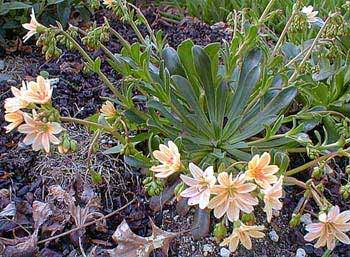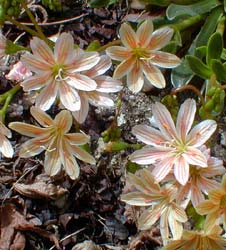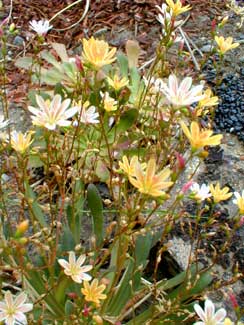 Pale Orange
Pale Orange
Siskiyou Cliff Maids or Bitterroot
"Many a flower is born to blush unseen."
-Thomas Gray
(1716-1771)
(1716-1771)
The pale orange Lewisia cotyledon var cotyledon is shown here in two April's end portraits followed by a July portrait.
It starts out gung-ho with spring flowers, usually skips a few weeks flower round about the cusp of May/June, then is gung-ho once more for early Summer. It can bloom again later still, depending on how hot the summer gets.
Lewisias are in general more cold-hardy than they are heat-hardy & will shrivel & go dormant for the hottest days of summer, though the leaves make a swift recovery when temperatures cool toward autumn.
 This specimen usually blooms a week or two ahead of most of the other Lewisias along that garden ledge, except the "Pale Pink" linked below, which also blooms early. All of them are well-budded by the end of March, with now & then the occasional March blossom, but April is the serious beginning for our Lewisia flowerings.
This specimen usually blooms a week or two ahead of most of the other Lewisias along that garden ledge, except the "Pale Pink" linked below, which also blooms early. All of them are well-budded by the end of March, with now & then the occasional March blossom, but April is the serious beginning for our Lewisia flowerings.The first ones to bloom in April, including this "Pale Orange," tend to have slightly smaller flowers, raised on higher stems. There are others in various stages of budding throughout the month, & some will wait to be in full bloom in May.
 Only a few of the color varieties we have are named cultivars or strains. Most of the ones we've had longest in our garden were started from seed in an Oregon nursery, whose stocks were initially obtained as seeds collected from wild plants that showed color variations.
Only a few of the color varieties we have are named cultivars or strains. Most of the ones we've had longest in our garden were started from seed in an Oregon nursery, whose stocks were initially obtained as seeds collected from wild plants that showed color variations.They have great variety to them when seed-grown & both their leaves & flowers can vary dramatically from plant to plant even within a given seed-stock.
Specialty growers are doing intraspecies hybridizations of the natural color variants & the subspecies & even some crosses with species other than L. cotyledon. The resulting strains frequently are named, such as "Sunset Strain" or "Ashwood Strain," or given specific cultivar names like 'Rondo.' But color & leaf variation is so broad that individual plants of any given type can vary most dramatically, so that identifying the strain in retrospect, if a label is lacking, is not apt to be possible.
The leaves on this particular specimen are rather slender, not wavy, with a slight spoon at the tips, forming rosettes reminiscent of hen-&-chicks. Other specimens can have leaves so much shorter they are practically round, & every length & shape in between may be encountered. Today's nursery-raised & seed-grown stocks are usually intraspecies hybrids showing the full range of features features rather randomly. When we've added these hybrids to our collectons, we've selected them in bloom, trying to get a full range of color forms as well as a full range of leaf forms.
The striped two-tone nature of most (but not all) Lewisia blossoms is particularly overt on this one. It further blooms in two colors, as some of the striped flowers are distinctly a pale orange or yellow-orange, others so much paler that the stripes become nearly pink, or "pink-orange."
The second photo attempts to capture the variant colors that occur even on the same stem of blossoms. The two distinct colors are even more obvious in the third photo.
The root plus caudex that shows at the surface under the rosette of leaves is often quite thick, & over time the caudex can lift the rosette a few inches upward. First peoples of the Northwest valued the root & caudex as a potato-like source of edible starch.
Lewisia cotyledon, Pale Pink